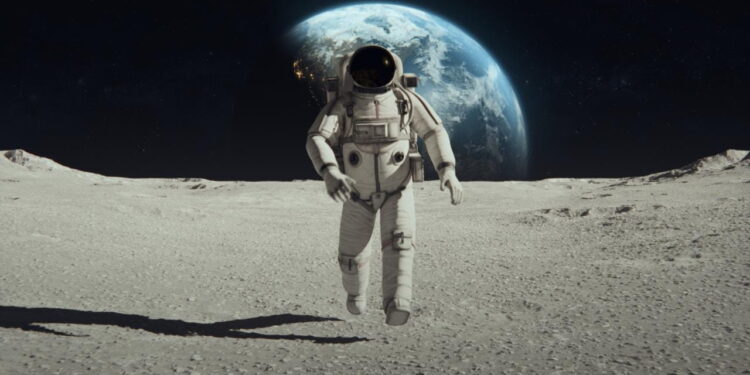NASA’s Artemis Program is a historic mission that will return astronauts to the Moon and lay the way for human exploration of Mars by the late 2020s. Named after the ancient Greek goddess of the Moon, the Artemis program will not just mark a return to lunar encounters, but a step forward into the cosmos and beyond. Artemis is ready to open a new chapter of human history as we once again prepare to go and see all that lies beyond Earth with an aim to sustain future human exploration of Mars. In this article, we consider the important aspects of the Artemis Program and the revolutionary innovation that will help humans return to the Moon.
🌕 The Goals of the Artemis Program
A pivotal aspect of Artemis is its commitment to landing the first woman and the next man on the lunar surface by 2026. This historic landing will not only mark a significant milestone in space exploration but also emphasize NASA’s dedication to inclusivity and diversity in the space sector. The crewed mission will land near the Moon’s South Pole, a region that has been largely unexplored and is believed to have significant water ice reserves.
1. Landing the First Woman and the Next Man on the Moon
Key to Artemis is sending the first woman and the next man to the lunar surface by September 2026. Not only will this historic landing serve as a key milestone in space exploration but it also will illustrate a very clear signal of NASA’s commitment to inclusiveness, diversity and will be a nod to the achievements of some of the greatest minds in computing history. The crewed mission will touch down near the Moon’s South Pole, an area that has been largely unexplored and is thought to have vast water ice deposits.
2. Building a Sustainable Presence on the Moon
Unlike the Apollo missions, which were performed as short-term, task-specific scientific expeditions, the Artemis program wants to develop a sustained human presence on the Moon. This will mean the construction of infrastructure like lunar habitats, power stations, and rovers for travel. The lunar base will be a proving ground for technologies and techniques needed for human missions to Mars and beyond. NASA wants to plant the seeds of a longer-lasting human presence in the late 2020s followed by regularly crewed missions after that.
3. Advancing Science and Technology for Mars Exploration
The Artemis Program is considered a preparation for the human exploration of Mars. NASA’s current long-term space goal is to pave the way for future human missions to Mars, using the Moon as a proving ground for the systems and technologies they will need for deep space travel, including life support, mining resources, and navigation. Specifically, Artemis will assist scientists and engineers in creating new technologies that can help transport astronauts to Mars, land them on the Red Planet, and ensure they can survive there for long durations in a harsh environment.
🚀 Key Components of the Artemis Program
To achieve its ambitious goals, the Artemis Program relies on a combination of new spacecraft, technology, and international collaboration. Several key components are being developed to enable the success of this next chapter in human space exploration:
1. Space Launch System (SLS)
NASA is building a new giant rocket called the Space Launch System (SLS) to launch astronauts and cargo into space. With its powerful takeoff capacity, SLS is going to be the strongest rocket that has ever been built, and with it the weight needed to be able to send cargo to the moon, and even beyond.
- Capabilities: The SLS can launch a crewed spacecraft into lunar orbit and carry cargo to the Moon. The spacecraft is intended to be capable of handling multiple missions, including ferrying crews, delivering cargo, and landing on the moon.
- Block 1 and Block 2 Configuration: The SLS will come in various configurations to transport respective payloads. Block 1 will be used for early crewed lunar missions, with Block 2 providing still more payload for deep space trips like Mars.
2. Orion Spacecraft
The Orion vehicle is the crewed spacecraft that will fly astronauts to and from lunar orbit. Orion – NASA’s next crew vehicle and the spacecraft designed to carry humans on long-duration deep space exploration missions – will be the backbone of NASA’s human spaceflight program.
- Crewed Mission Capability: Orion can transport as many as four astronauts to the lunar surface as they cruise to the Moon in habitation. The craft is equipped with cutting-edge life-support systems, radiation protection and first-rate communication.
- Lunar Gateway: The Orion spacecraft will also be part of the Lunar Gateway, a station that will orbit the Moon. The Gateway will also act as a jumping-off point for lunar missions, a place where astronauts can rest and resupply before descending to the surface.
3. Human Landing System (HLS)
The Human Landing System (HLS) is the spacecraft that will land astronauts on the Moon’s surface and return them to lunar orbit. NASA has chosen a handful of companies to develop HLS prototypes, and SpaceX is among the ones farthest along, building a version of its Starship vehicle designed specifically to land humans on the moon during Artemis missions.
Access to the Moon: The HLS will bring astronauts from the Lunar Gateway down to the surface of the Moon and return them back home, to get us there and back safely and easily. The spacecraft is intended to pair with the Gateway in order to give astronauts everything they need for a lunar mission.
Lunar Habitats: Complementing landing, the HLS will help to enable a sustained human presence on the lunar surface, with capabilities for long‐duration habitation, consisting of life support, power systems, and other logistics.
4. Lunar Gateway
The Lunar Gateway is a small space station that would orbit the Moon and would be a housing post for astronauts who are on the Moon to undertake lunar missions. The Gateway will support surface lander operations as a staging point, providing access to the lunar surface, while TAC evaluates the normal operations for a surface lander.
International Partners: NASA’s international partners, including the European Space Agency (ESA), Russia (and other countries on the International Space Station), Japan and Canada, will join in a commitment to build and use the Gateway. These other partners will provide critical elements like docking ports, power systems, and comms systems minimum investment.
Research Platform: The Gateway will be used as a platform for robotic science anywhere on the Moon and on, above or below the lunar surface. It will help to test technologies to be used for human exploration to Mars, such as life support, deep-space communications and in-space propulsion.
🌍 The Impact of Artemis on Global Space Exploration
The Artemis Program, as NASA’s plan is called, is not an American effort only; it’s global. The programme then relies on its interational partnerships to make it hapen, courtesy of space agencies around the world. These partnerships will provide a new approach for global space exploration and allow the benefits of exploring the Moon to be shared by other countries.
International Partnerships
Nations from around the globe are participating in Artemis, lending their specific expertise in space exploration, science and technology. Some key partners include:
European Space Agency (ESA): The ESA is supplying key components for the Lunar Gateway such as Habitation module and power systems 2. The agency will also have a hand in building the Orion space vehicle.
Japan: Japan is supporting Gateway with the development of the Logistics Module and crucial technology for surface exploration.
Canada: Canada is contributing the Canadarm3, a robotic arm to help with activities on the Gateway and during lunar missions.
- Global Scientific and Technology Benefits
Artemis won’t just shed light on the Moon, it will also have a positive impact on humanity, such as the development of new technologies and international cooperation. The knowledge and experience we gain from lunar exploration will enable us to better understand the Moon’s resources, geology, and history and prepare us for eventual missions to Mars and other destinations.
Technological Development: The technologies created for Artemis will be applicable to other industries—from communications to energy to robotics. And Artemis is pushing the more envelope of space, getting more out of each mile we travel, driving advancements that will help improve life on Earth.
🌠 The Road to Mars: Artemis as a Stepping Stone
The Artemis Program is more than just a return to the Moon, it is mankind’s next step in the eternal quest: Mars. Teaching people to live and work on the Moon will give astronauts the experience they need for that longer (and more complicated) trip to Mars. Artemis is paving the way for human exploration of the Red Planet and beyond, moving humanity closer to the reality of living and working on another world.
- Mars Missions: With Artemis, NASA is testing life support systems, propulsion systems and resource utilization that will be necessary for extended trips to Mars. Among them is finding ways to make fuel, water and oxygen from the Moon’s own resources — a technology that would be crucial for deep space missions.
- Moon to Mars Sustainability: Establishing sustainable lunar exploration with Artemis will enable the possibility of sustainable Mars exploration. What we learn from transiting to habitation on the moon, to energy generation on the moon, is all transferable back to the way we live in space in interplanetary transit.
🚀 Conclusion: A New Era for Exploring the Moon
The program is seen as an important stepping stone in achieving the goals of the Artemis Program, humanity’s return to the Moon and eventual establishment of a sustainable presence there, leading to deeper space exploration. Artemis is ushering in the next generation of space exploration, created through collaboration among government, industry, and academia, and open to the world, and will serve as the backbone of an entirely new lunar economy even as we partner with other nations and establish new precedents in space. This next giant leap for lunar exploration is not all about revisiting the past — it’s about preparing for the thrilling future.


